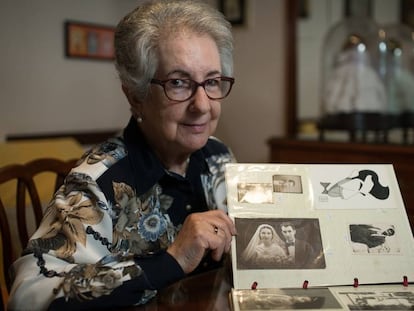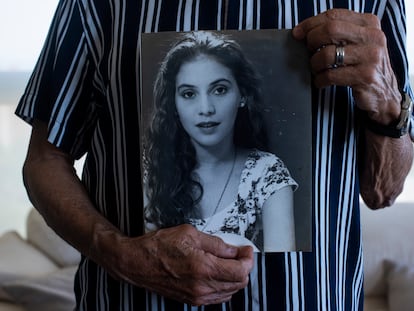Death of Spain’s Diego Bello in the Philippines: How the police version was debunked
A new investigation has disproven the first official explanation of the 2020 killing, which claimed the 32-year-old Spaniard was a drug lord who had died in a shootout
On January 8, 2020, when Diego Bello’s family and friends were told that the 32-year-old had died in a police shootout in the Philippines, nobody believed it. It was as if they were being told about a stranger. The surfer from Spain’s Galicia region had been living in Siargao since 2017, and had started several businesses on the island. But according to police, he was a drug lord – an accusation that rang false with all who knew him. Now a new investigation, triggered by the family’s protests and diplomatic pressure, has reached the same conclusion, and the three police officers who shot Bello have been charged with murder, perjury and falsifying evidence.
According to Human Rights Watch, Diego Bello is one of the 12,000 people who have died in the Philippines at the hands of the police in alleged drug operations since 2016, when President Rodrigo Duterte began his violent war against trafficking. Bello’s case is also one of 52 that have been reviewed by the country’s Department of Justice (DOJ), following years of protests from human rights organizations. In all 52 cases, investigators found signs that the deaths were extrajudicial killings. The Duterte administration, which faces elections soon, has promised to analyze another 6,000 homicides. The official report from the DOJ, which is the equivalent of Spain’s public prosecutor, debunks the police version of Bello’s death thanks to witness statements, an analysis of police archives and a review of the crime scene.
Bello was shot to death outside his home. It was 1.35am and he had just gotten back from working in the restaurant that he managed. Both his neighbors and his girlfriend, who was inside his house at the time, heard the shots. The shots were fired by captain Wise Vicente Panuelos, the police chief who is one of the three officers now charged with murder, perjury and falsifying evidence. Panuelos maintained that Bello was killed in a drug operation. According to this version of events, Panuelos was leading a team to arrest the businessman from Galicia by setting a trap. The story went that one of his men, sergeant Ronel Pazo, who is also being investigated, had arranged to meet Bello outside his home to buy drugs. Once the deal was done, the third accused officer, sergeant Nido Boy, was meant to arrest the 32-year-old. But the three said that they were “forced to defend themselves,” after Bello, realizing he had been set up, shot first and tried to escape.
The new investigation, however, concludes that the shootout never happened, but was rather an “invented scenario.” Bello never took a pistol from a belt bag, as alleged by the three police officers, nor did he fire twice as he tried to flee. At the scene of the crime, bullet casings from two different calibers were found: one belonged to the guns used by the officers, and the other allegedly to the weapon wielded by Bello. But according to the investigation, the position of the casings indicates that the shooters were standing so close to one another that it would have been impossible for Bello to have been the only victim.
That is not all: there is a large amount of evidence that disproves the first official version of the murder. The trajectory of the bullets allegedly fired by Bello does not match with the officers’ description of how he fled. Blood stains and the damage at the crime scene also contradict the officers’ version of events. The last shot, for example, did not come from the gun supposedly used by Bello, but rather the police chief. And it is believed it was fired when the surfer had nearly fallen to the floor.

According to the DOJ, it is “evident” that accusing Bello of carrying a weapon was “part of a big plan to justify the illegal homicide.” The investigators discovered that the gun alleged to have belonged to Bello was in the name of a business based in Manilla, which denied that it stocked the weapon. It was impossible, the investigators said, to establish a link between this company and Bello, given that the Spaniard had only been living in the Philippines for three years, while the gun had been registered by the firm more than two decades ago.
Bello’s name was also not on the official list of drug traffickers, which has been kept since 2016. Panuelos also insisted that the 32-year-old was a regional trafficker despite the fact that there was no reference to him in the Philippine Drug Control Agency. This body also confirmed that it had not been involved in the operation led by Panuelos. The autopsy carried out in Madrid concluded that Bello had not taken any kind of drug in the six months prior to his death.
At the scene of the crime, which investigators believed was staged, 15 grams of cocaine was found as well as a belt bag, which Bello allegedly used to carry his gun. But he was not wearing this item when he left his restaurant to go home, as is clear from security camera footage recorded at the establishment. The investigation accuses the officers of shooting a defenseless person, when they themselves were armed and had support from other police officers working in the area. The autopsy carried out in the Philippines showed that Bello had been shot six times, with the last bullet hitting his right ear. The DOJ report concludes that the three officers shared a “common goal, a unity of action and a common interest: to kill Diego.”
Unanswered questions
This twist in the case has surprised the relatives of Diego Bello, who have been fighting for nearly two years from A Coruña in Galicia to get justice in the Philippines. They have faced enormous difficulties, but were finally able to find a law firm in the country that has appeared on their behalf in the suit. The family, however, have said they will take their case to Spain’s High Court, the Audiencia Nacional, or the International Criminal Court (ICC), if the process is not carried out with the proper legal guarantees. Now they are also calling on Spain’s Foreign Affairs Ministry to help them cover their legal fees. “We were not expecting anything [in the Philippines], and now, suddenly we see the light,” said Guillermo Mosquera, who has been working on the case with Manuel Ollé Sesé, an expert in international law.
The Foreign Affairs Ministry says that it has been “closely following” Bello’s killing and has promised to “continue giving special attention” to the case against the three police officers. One of the officers, Captain Panuelos, met with the Spanish consul days after Bello’s murder to say that there was “solid evidence” against the Spaniard, according to local press. Later, representatives from Spain held meetings with the justice and interior ministries of the Philippines to urge the country to review Bello’s case.
This review has debunked the first official version of the murder, but has not reached a conclusion on the motivation for the crime. “My opinion is that the narco campaign was used to settle something personal against him and that’s why they put the drugs and the weapon there. But the only person who can tell us what that ‘something personal’ is is Diego,” said Mosquera. “I don’t know what happened, nor if we will find out some day. What we are looking to do is to clear his name and show that it was all a set-up to kill him.”
The Commission of Human Rights in the Philippines, which was the first organization to call into doubt the police version, has found a connection between Bello and one of his accused killers. Panuelos comes from Camarines del Sur province, where the governor is Migz Villafuerte, a member of a powerful political family. According to the commission’s report, which was published before Panuelos was accused, five months before the murder, Villafuerte went to one of Bello’s businesses to complain about the noise and threatened Bello’s partner: “Don’t you know who I am? I could shoot you and make you disappear by throwing you in the swamp.”
Tu suscripción se está usando en otro dispositivo
¿Quieres añadir otro usuario a tu suscripción?
Si continúas leyendo en este dispositivo, no se podrá leer en el otro.
FlechaTu suscripción se está usando en otro dispositivo y solo puedes acceder a EL PAÍS desde un dispositivo a la vez.
Si quieres compartir tu cuenta, cambia tu suscripción a la modalidad Premium, así podrás añadir otro usuario. Cada uno accederá con su propia cuenta de email, lo que os permitirá personalizar vuestra experiencia en EL PAÍS.
¿Tienes una suscripción de empresa? Accede aquí para contratar más cuentas.
En el caso de no saber quién está usando tu cuenta, te recomendamos cambiar tu contraseña aquí.
Si decides continuar compartiendo tu cuenta, este mensaje se mostrará en tu dispositivo y en el de la otra persona que está usando tu cuenta de forma indefinida, afectando a tu experiencia de lectura. Puedes consultar aquí los términos y condiciones de la suscripción digital.
More information
Últimas noticias
Tiger Woods turns 50: Will he continue playing on the PGA Tour or take a back seat?
The surreal journey of James Nnaji, the Barcelona youth player selected in the NBA Draft who ended up in the NCAA
Trump claims peace in Ukraine is near, but Moscow suggests otherwise
A survivor’s account of the Interoceanic Train accident: ‘We were scared because of the speed on the curve’
Most viewed
- Oona Chaplin: ‘I told James Cameron that I was living in a treehouse and starting a permaculture project with a friend’
- Reinhard Genzel, Nobel laureate in physics: ‘One-minute videos will never give you the truth’
- Why the price of coffee has skyrocketed: from Brazilian plantations to specialty coffee houses
- Pablo Escobar’s hippos: A serious environmental problem, 40 years on
- Chevy Chase, the beloved comedian who was a monster off camera: ‘Not everyone hated him, just the people who’ve worked with him’











































